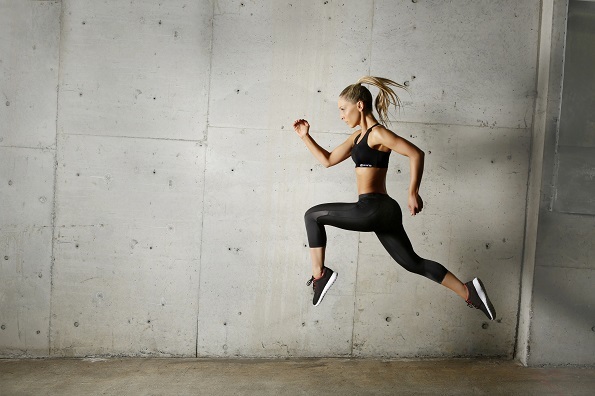By Rain Francis of Dance Informa.
Compression products are now standard fare for exercisers of all persuasions. Everyone from runners to rugby players to dancers can be seen training in their Skins, and as a happy by-product, the general public’s irrational fear of ‘men in tights’ seems to have, at last, abated.
There are various compression products on the market. Some, such as Coda Compression socks, are aimed specifically at dancers. Others, including Skins and 2XU, are marketed to a more general athletic audience but are popular amongst dancers, particularly ballet dancers.
Amongst the many benefits these products claim to offer are better recovery from exercise, an enhanced warm-up due to increased skin temperature, increased jump height and power, and a reduction in delayed onset muscle soreness (DOMS).
So, do compression products actually work – and do they work for dance? I set out to find an answer to this question, but found it difficult to pin one down, as much of the research on the topic is conflicting and inconclusive.
The ideology behind compression garments is nothing new, in fact medical compression stockings have been used for several decades to improve venous blood flow in patients. And anyone who has been on a long-haul flight will know the benefits of wearing compression socks in a bid to avoid the dreaded ‘kankles’, or – on a more serious note – deep vein thrombosis.
According to several studies cited by the Australian Sports Commission, there is some evidence that compression garments may enhance the removal of lactate from muscles (the build-up of which has been linked to DOMS), improve jumping power and height (due to an improved warm-up via increased skin temperature) and reduce risk of injury – as well as other benefits.
The Commission also cited studies which were unable to find any evidence of the usefulness of these products, however “it appears the use of compression garments may have a positive effect on athletes during exercise and during recovery periods following exercise. As no studies have reported negative effects on exercise performance or perceptions of pain, the use of compression garments may provide a useful training tool for athletes across a wide variety of sports.”
It concluded that “caution should be taken when choosing the correct compression garment for your sport and ensuring the garment provides enough pressure to promote venous return.”

Skins fashionable compression garments. Photo courtesy of Skins.
Scientific studies aside, many dancers today swear by their shiny black structured tights, so they must be doing something right.
Georgina Hagerty, a freelance dancer currently performing with The Australian Ballet says, “I use 2XU socks for recovery between shows and sometimes overnight when my legs are really tired. They help a lot. I get a lot of fatigue in my lower legs when I’m doing a heavy workload and hard ballets, and the socks really help to ease tension, helping my legs recover faster.”
“I wear compression gear at night to restore and repair my muscles, so I’m ready for my next ten-hour day,” says dancer Gemma Corlass-Brown. “My muscles are not completely recuperated unless I wear them.”
“I was always a little skeptical about what compression tights actually do,” says freelance dancer Johanna Lee. “Having since tried them before, during and after rehearsals, I’ll never go back! I noticed a considerable decrease in muscle fatigue during rehearsals. I never really like to cover my legs up with tights or pants too much, as I feel it restricts my dancing, but 2XU tights are like a second skin – they really move with you. I highly recommend giving them a go.”
Sydney-based freelance artist Linda Badger is also a fan of wearing compression tights for ballet class, saying they really help her to feel “lighter and springier. [They] can get a bit hot and adage is a bit harder, but jumps are awesome. And they help muscles recover faster,” she adds.
Iona Marques of Melbourne City Ballet says: “I’ve been using Skins for a while. Sometimes I like taking class with them also; they breathe well and I move well in them. I tried them overnight, but I don’t actually like the constriction when I sleep.”
Sakura Shimizu, ex principal dancer with Melbourne Ballet Company and director of City Dance Centre adds, “I used to sleep in full body 2XU (high neck, long sleeve top with full tights) after performances. They help so much with recovery.”
To add my two cents to the discussion, I have to agree. In my case – returning to dance after an ankle injury – I’ve been looking for all the help I can get, and I really believe both my Coda Compression socks and my Skins A400 have delivered. I choose to wear my Skins for class and my Codas post-training, and they simply feel ‘right’. Especially returning to pointe work – the most extreme end of ballet technique, I have really been feeling the strain on my legs. The effect of wearing compression garments during and post training feels akin to soaking my lower legs in ice or laying with my legs up the wall (or any of the other quirky post-rehearsal rituals we dancers might use to aid recovery.)
There is a chance that there is an element of the placebo effect at work here, but can’t that be just as beneficial as ‘the real thing’? I mean, it feels good, therefore it’s doing me good. My legs, ankles and feet feel better, I’m able to perform at the level required of me, and that’s really all that matters. That, and looking good in class. And if there’s one thing Skins definitely do, it’s create a flattering silhouette – and every dancer likes that, right?
For additional information, please visit: http://www.ausport.gov.au/sportscoachmag/sports_sciences/compression_garments_do_they_influence_athletic_performance_and_recovery
Photo (top): Skins compression garments. Photo courtesy of Skins.

















